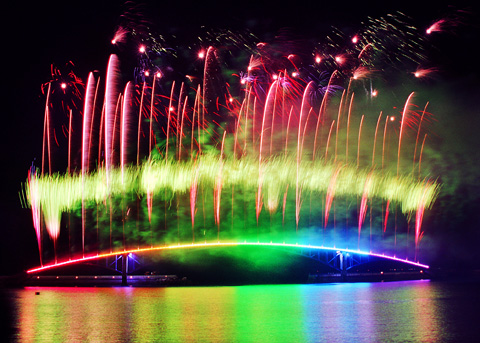Erecting a statue of a has-been celebrity’s grandmother. Scheduling an annual festival around the anniversary of a horrific airline crash. These might not sound like good ways to promote tourism, but they seem to work for Penghu.
And as far as the Penghu County Government is concerned, there’s no better way to open a program of summer activities than with fireworks. Lots of them. The Penghu Fireworks Festival (澎湖花火節) starts tomorrow night, and after that the sky above the archipelago will pulsate with explosions of color on every Wednesday and Saturday night until June 7.
The festival has been popular with locals since it began in 2003. This year, in addition to the skies over the Siying Archway Bridge (西瀛虹橋) near the main town of Makung (馬公市), there will be fireworks displays over the Penghu Sea-Crossing Bridge (跨海大橋) in Paisha Township (白沙鄉) and the Kuanri Recreational Area (觀日遊憩區) in Huhsi Township (湖西鄉). The pyrotechnics are scheduled to start between 8:30pm and 8:45pm.

PHOTO BY LU CHAN-YUAN, COURTESY OF THE PENGHU COUNTY GOVERNMENT
The Fireworks Festival is the result of efforts to boost tourism after a China Airlines crash near the archipelago on May 25, 2002, killed 19 crewmembers and 206 passengers. Tourism to the archipelago plummeted, so the following year the county government and China Airlines cooperated to stage a show in which air hostesses and stewards performed a program inspired by the Moulin Rouge (the mind boggles), followed by a display of fireworks. By all accounts, the event was a huge success and the Penghu Fireworks Festival was born.
This year, a warm-up for the festival took place on April 26, when the county government sponsored a concert featuring the ubiquitous pop idol Aska Yang (楊宗緯) and local son Pan An-pang (潘安邦), whose rendition of his song Grandmother’s Penghu Bay (外婆的澎湖灣) received a rapturous reception — at least according to local media reports.
The campus-style song (校園歌曲) that helped establish Pan as a celebrity — when it was released in 1979 — has done wonders for Penghu tourism. In a May 5 report in the United Daily News, Hung Tung-lin (洪棟霖), director of Penghu’s Tourism Bureau (澎湖縣旅遊局), is quoted as saying the song had made Penghu one of the top destinations for Chinese tourists visiting Taiwan.
To capitalize on this, the county government has created a tourism venue based on the song, complete with a statue of Pan’s grandmother. According to the report, local authorities have requested that the Navy lift restrictions to the beach area where Pan and his grandmother are described in the song as strolling along the waterfront. Pan is quoted as saying that he thought it was a great idea, but that he did not have any connection with anything at the new tourism venue.
But it’s not all ersatz: This year’s Fireworks Festival includes real local religious rituals and other traditional activities. Officials hope the fireworks will create a spectacular end to a day spent enjoying the unique features of the island chain’s cultural life, visiting its many historic sites, and sitting on the shores of “Penghu Bay.”
More information about the festival and related events can be found at the festival’s Web site, firework.travel-web.com.tw.— IAN BARTHOLOMEW

Many people noticed the flood of pro-China propaganda across a number of venues in recent weeks that looks like a coordinated assault on US Taiwan policy. It does look like an effort intended to influence the US before the meeting between US President Donald Trump and Chinese dictator Xi Jinping (習近平) over the weekend. Jennifer Kavanagh’s piece in the New York Times in September appears to be the opening strike of the current campaign. She followed up last week in the Lowy Interpreter, blaming the US for causing the PRC to escalate in the Philippines and Taiwan, saying that as

This year’s Miss Universe in Thailand has been marred by ugly drama, with allegations of an insult to a beauty queen’s intellect, a walkout by pageant contestants and a tearful tantrum by the host. More than 120 women from across the world have gathered in Thailand, vying to be crowned Miss Universe in a contest considered one of the “big four” of global beauty pageants. But the runup has been dominated by the off-stage antics of the coiffed contestants and their Thai hosts, escalating into a feminist firestorm drawing the attention of Mexico’s president. On Tuesday, Mexican delegate Fatima Bosch staged a

Taiwan can often feel woefully behind on global trends, from fashion to food, and influences can sometimes feel like the last on the metaphorical bandwagon. In the West, suddenly every burger is being smashed and honey has become “hot” and we’re all drinking orange wine. But it took a good while for a smash burger in Taipei to come across my radar. For the uninitiated, a smash burger is, well, a normal burger patty but smashed flat. Originally, I didn’t understand. Surely the best part of a burger is the thick patty with all the juiciness of the beef, the

Would you eat lab-grown chocolate? I requested a sample from California Cultured, a Sacramento-based company. Its chocolate, not yet commercially available, is made with techniques that have previously been used to synthesize other bioactive products like certain plant-derived pharmaceuticals for commercial sale. A few days later, it arrives. The morsel, barely bigger than a coffee bean, is supposed to be the flavor equivalent of a 70 percent to 80 percent dark chocolate. I tear open its sealed packet and a chocolatey aroma escapes — so far, so good. I pop it in my mouth. Slightly waxy and distinctly bitter, it boasts those bright,